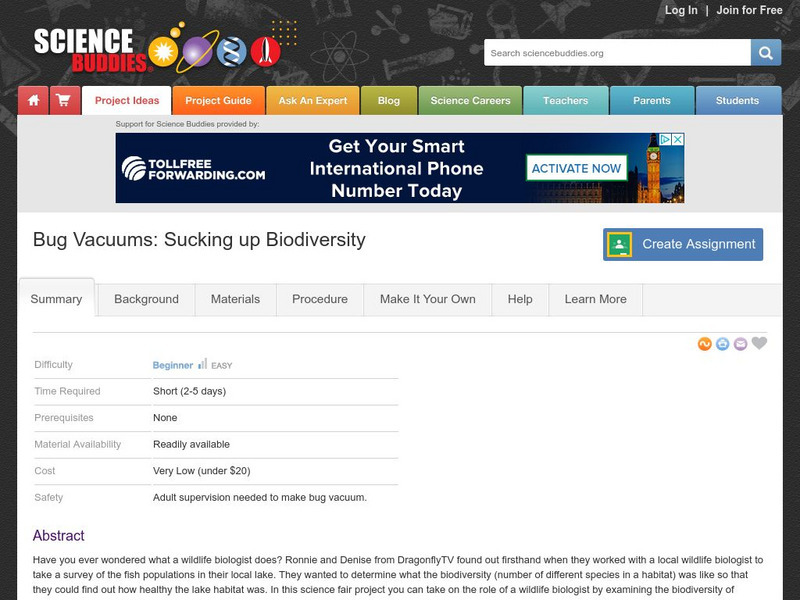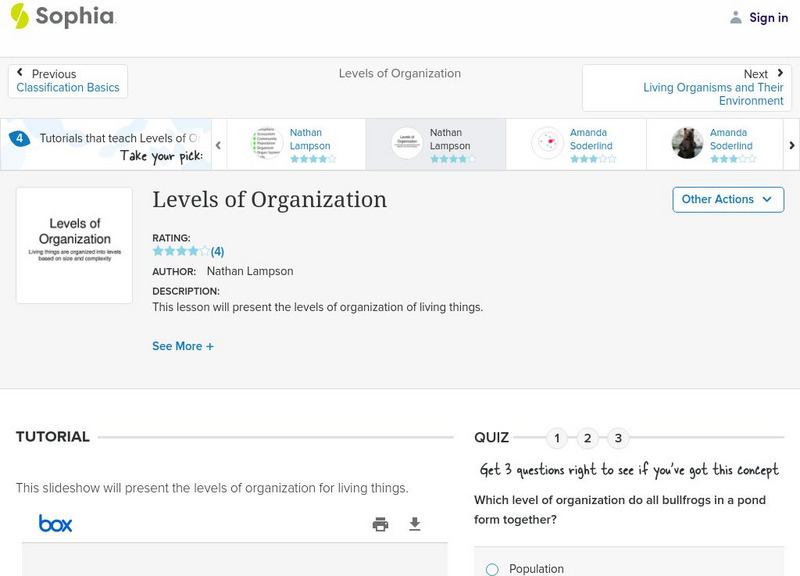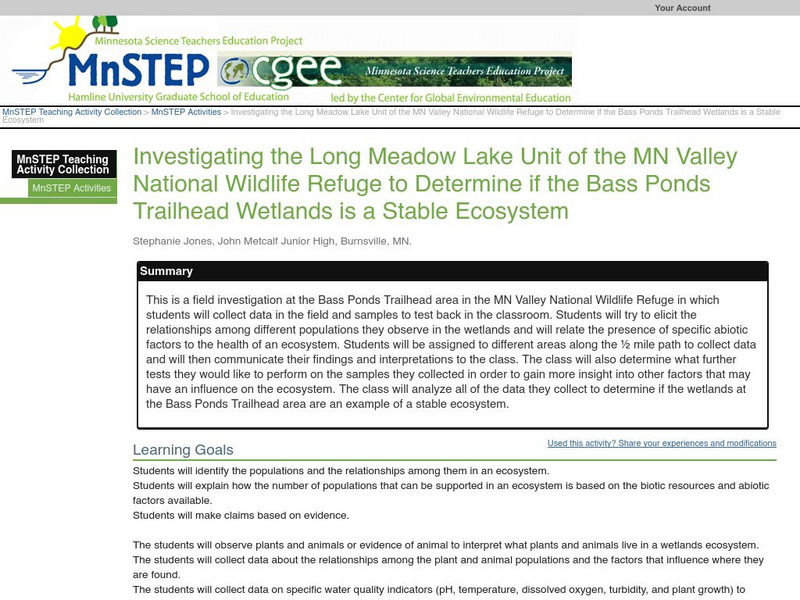Other
Virginia Places: What Determines the Boundaries of a Region in Virginia?
Although this site talks about regions in Virginia, it offers excellent information on regions in general, for example, ways regions might be classified; e.g., by population density, geology, watershed, ecosystem, economy,...
Scholastic
Scholastic: Endangered Ecosystems: Costa Rican Caterpillars
Go on a mission to Costa Rica and Mexico, and explore the state of tropical rain forest ecosystems by examining Costa Rican caterpillars. Learn what the change in this animal's population means for the rest of the ecosystem.
Massachusetts Institute of Technology
Mit: Open Course Ware: Courses: Civil Environmental: Ecology I: The Earth System
College-level online course highlighting the fundamentals of ecology. Course topics include coevolution of the biosphere, geosphere, atmosphere, and hydrosphere; photosynthesis and respiration; and the carbon, nitrogen, and water cycles....
ClassFlow
Class Flow: Understanding Ecosystems: Part 1 of 4
[Free Registration/Login Required] Students will get an introduction to ecosystems. They will be able to distinguish nonliving and living thins in a habitat.
TeachEngineering
Teach Engineering: Computer Simulation of the Sonoran Desert Community
The computer program's simulation of a Sonoran desert community should ultimately strengthen the student's comprehension of what is required for a natural ecosystem to sustain itself (remain in balance). This computer simulation program...
Science Buddies
Science Buddies: Bug Vacuums: Sucking Up Biodiversity
In this science fair project you can take on the role of a wildlife biologist by examining the biodiversity of insects in your own backyard. To do this, you will follow the directions to create a homemade bug vacuum.
Cosmo Learning
Cosmo Learning: Principles of Evolution, Ecology and Behavior
A collection of video lectures introducing beginning biology students to the principles of evolution, ecology, and behavior. The course was taught three times a week for a semester at Yale University. The course discusses concepts of...
Alabama Learning Exchange
Alex: Endangered Species
This is a biology or environmental science instructional activity that incorporates technology. This project-based plan is designed to be used as students study the factors that affect the dynamic equilibrium of populations and...
American Institute of Biological Sciences
Action Bioscience: The Decline of North American Freshwater Fishes
An article addressing the need of immediate action to repair damages of declining life in the ecosystems of North American inland bodies of water.
PBS
Pbs Learning Media: Wildlife Biology
In this What's Up in the Environment? video segment, learn how various indicator species are used to monitor the environmental condition of the Everglades.
PBS
Pbs Learning Media: Dustin Madden: Science Teacher
In this video profile produced for Teachers' Domain, meet teacher Dustin Madden, an Inupiaq who hopes to inspire students to take an active role in protecting the natural environment by giving them a foundation in math and science.
CK-12 Foundation
Ck 12: Life Science: Levels of Ecological Organization
[Free Registration/Login may be required to access all resource tools.] Ecosystems are organized into several different levels, and they can be studied at any one of the various levels of organization. Learn more about levels of...
Sophia Learning
Sophia: Levels of Organization: Lesson 4
This lesson will present the levels of organization of living things. It is 4 of 6 in the series titled "Levels of Organization."
American Institute of Biological Sciences
Action Bioscience: Species, Speciation and the Environment
The American Institute of Biological Sciences offers this article by Niles Eldredge, evolutionary theorist and curator at the American Museum of Natural History. Eldredge begins with Darwin's theories and summarizes subsequent thought,...
PBS
Nh Pbs: Nature Works: Estuaries
Learn more about estuaries when you visit this informative site. This resource provides locations of and weblinks to estuaries in the United States.
Concord Consortium
Concord Consortium: Stem Resources: Natural Selection
Build a dam in the middle of an ecosystem and observe how the population of plants and animals adapt to their new environment with this science simulation. Learn how the populations adapt to survive in their new habitat. Then remove the...
Concord Consortium
Concord Consortium: Stem Resources: Predators and Prey
Did you ever want to be a hawk? In this virtual ecosystem, students will take on the role of a hawk and try to catch rabbits on a snowy field. Students will see which rabbits have adaptations that allow them to blend into the environment...
Annenberg Foundation
Annenberg Learner: The Habitable Planet: Ecology Lab
Create the parameters of your own ecosystem by choosing which producers and consumers live there. Visualize how the food web operates and species populations change. This simulator mimics the food web within a typical ecosystem and gives...
PBS
Pbs: River Rewilding: Grand River Restoration and Revitalization Project
A unit for students to look at the economic opportunities associated with a river. Students will explore the Grand River Revitalization & Restoration Project. In this unit, they will also learn about two species impacted by the...
BSCS Science Learning
Bscs: Frog Eat Frog World
Using maps and graphs of large data sets collected in FrogWatch, students will determine the range, preferred land cover, and proximity to water of the American bullfrog to figure out the bullfrog's requirements for food, water, and...
Science Education Resource Center at Carleton College
Serc: Investigating the Long Meadow Lake Unit of Valley Nat'l Wildlife Refuge
This is a field investigation at the Bass Ponds Trailhead area in the MN Valley National Wildlife Refuge in which young scholars will collect data in the field and samples to test back in the classroom. Students will try to elicit the...
Other
Vancouver Aquarium: Harbor Seals
Are harbour seal populations endangered? What role does the harbour seal play in the ecosystem? How does the harbour seal reproduce? Find the answers to these questions and more in this enlightening site.
Science Education Resource Center at Carleton College
Serc: Investigating the Ecology of Goldenrod Galls Through Biological Sampling
In this biology field lab exercise, learners conduct a stationary population study of goldenrod galls. They examine a host of factors including goldenrod plant density, goldenrod gall density, gall height, gall mass, larval exit hole...
Other
Digital Library for Earth System Education: Teaching Box: Seasonal Upwelling
A suite of lessons focusing on the process of upwelling. Inquiry-based exploration of seasonal upwelling includes marine food webs, food production in the ocean, wind-driven ocean currents, and seasonal changes in biotic and abiotic...
















